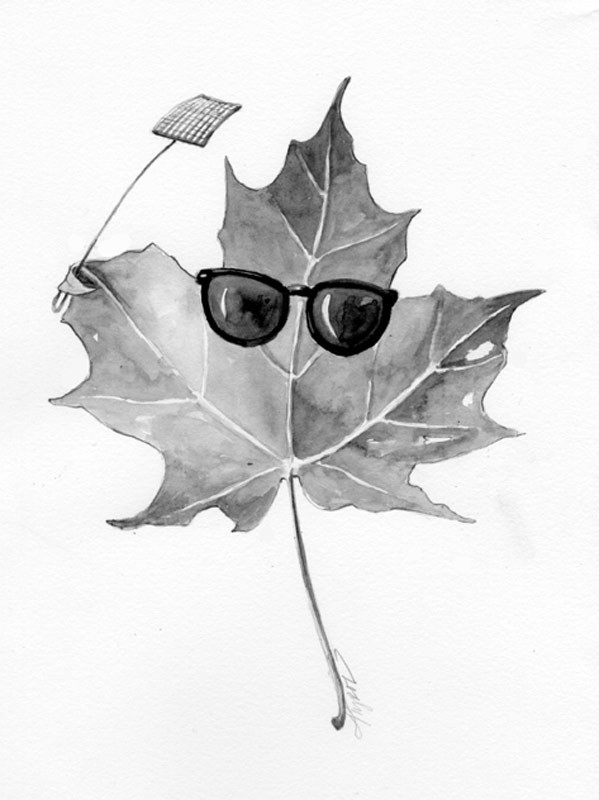
Last weekend, my four-year-old niece asked me why leaves turn red. Dang it; why couldn’t she have asked me an easier one? Like, why do leaves turn green? Or even yellow?
Nobody knows precisely why leaves turn red in the fall. Why they turn yellow and brown is easier to explain: that’s the color leaves already are. Once autumn comes and the trees stop replenishing the chlorophyll in their leaves – chlorophyll is the key compound in photosynthesis and it’s green – the leaves revert to their underlying tones, which run heavily to yellow and brown.
Reds, however, which, along with purples and oranges come from anthocyanin pigments, are manufactured by the leaves on the spot as autumn deepens. This raises the question of why. The yellows and browns are an artifact of the end of photosynthesis and don’t require additional explanation, but the red pigments must have a reason behind them since the tree is using precious energy to put on a fiery show.
Two theories have been advanced so far. The first is that the trees are trying to protect themselves from insect infestations. Red is often used as a warning or danger signal in the natural world, and the idea is that the trees are trying to warn potential insect invaders that, although the season is progressing and the leaves are dying, the tree is still healthy enough to mount a vigorous chemical defense. Go pick on some tree that isn’t as red and threatening is the idea.
But this theory leaves a number of things unexplained, mainly, why is it that the vibrancy of red foliage varies so much from year to year, and not in relationship to insect outbreaks? Also, since the leaves are pretty well spent and about to be discarded, wouldn’t it be easier and cheaper for the tree just to let them get chomped?
A variation on the insect theory says that the red isn’t a warning sign; it’s a disguise, since many insects are hard-wired to seek the color green. This theory makes particular sense in the spring, when many of our trees sport reddish foliage just as their leaves are emerging and just as many feeding insects are also emerging. Here again, though, a key detail remains unexplained: why doesn’t the tree just use the underlying carotene pigments in the leaves, which would presumably accomplish the same deception at a cheaper price?
The rival theory of red leaves is that the purpose of the anthocyanins is to protect the leaves as the chlorophyll is decaying, acting as something of a sunscreen. Chlorophyll’s job, after all, is to absorb as much of the sun’s energy as possible, so it makes a certain amount of sense that when stripped of this protection, the leaves would be susceptible to damage. This theory dovetails nicely with the observation that foliage is more brilliant in years with sunny autumns, since the trees presumably need to slather on more sunscreen.
But the trouble here is that anthocyanins only absorb energy in a limited part of the spectrum, much narrower than chlorophyll, meaning that the leaves are still vulnerable to damaging ultraviolet light despite the extra effort. If sunscreen is the goal, why wouldn’t trees use a broad-spectrum variety?
A new wrinkle in the sunscreen theory is the observation that red foliage is more brilliant on soils that are poor in nutrients, especially nitrogen. The cost of producing anthocyanins may be well worth paying when depleted soils make it beneficial for a tree to reclaim as much nutrition as possible; the anthocyanins mount a sort of rear-guard campaign, protecting the leaves for as long as possible while the contents of the foliar storerooms are transported back to the tree.
The chamber of commerce is hoping that this theory doesn’t hold up, because we are currently bathing the biosphere in additional nitrogen through the combustion of fossil fuels, an act that could, therefore, be snuffing out the brilliance of autumn.
Here’s another puzzle: why do nearly 70 percent of the tree species in New England produce some amount of anthocyanin while the average for temperate tree species around the world is only about 10 percent? In other words, why is New England the capital of fall foliage?
Here again, we don’t know, though there is the intriguing observation that the best foliage is found in regions that were once scoured by continental glaciers. We do know that the chamber of commerce hasn’t been around long enough to take credit.
Back to my niece, with her upturned face, inquiring eyes, and question about red leaves hanging in the air. I tried to change the subject. “They sure are beautiful, aren’t they?”


Discussion *